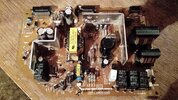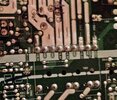I have an older Hitachi Rear Projection TV that still works great or I should say did work great until 3 or 4 days ago. I came in and tried to turn it on and it was just dead. So, I unplugged it and plugged it back in. Nothing, not even the slight click that it makes when you plug it in. So, I removed the power supply board and inspected it visually for bulged caps or burnt spots, anything that didn't look right and couldn't find anything.
I noticed on the bottom of the board there was a row of solder joints with voltages printed next to them(10.5v, Gnd, Gnd, 5.6v, 5.6v, Gnd, 16.5v, Audio Gnd, Audio), which are coming from the large transformer on top. I checked all of these voltages and they're all reading between 12.5 to 12.7 volts except for the 16.5v joint and it's reading .6 volts. I'm not an electronics technician but I assume this isn't right.
I would really appreciate any help anyone could give me in fixing this issue. It's an old TV but it shill has a great picture an I would prefer to fix it if I can. As I said I'm not an electronics technician but I can desolder/solder components, so if I could just figure out which one/s are bad I might be able to fix it.
Thanks in advance.
I noticed on the bottom of the board there was a row of solder joints with voltages printed next to them(10.5v, Gnd, Gnd, 5.6v, 5.6v, Gnd, 16.5v, Audio Gnd, Audio), which are coming from the large transformer on top. I checked all of these voltages and they're all reading between 12.5 to 12.7 volts except for the 16.5v joint and it's reading .6 volts. I'm not an electronics technician but I assume this isn't right.
I would really appreciate any help anyone could give me in fixing this issue. It's an old TV but it shill has a great picture an I would prefer to fix it if I can. As I said I'm not an electronics technician but I can desolder/solder components, so if I could just figure out which one/s are bad I might be able to fix it.
Thanks in advance.


